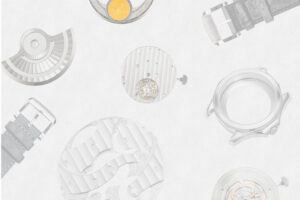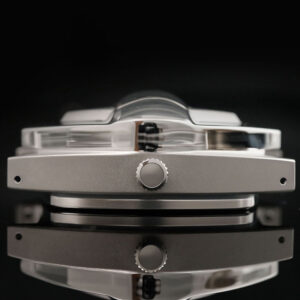The Hidden Complexity Behind Mechanical Watches
Introduction: Understanding the Structure Behind Precision
When someone asks, “How many parts are in a mechanical watch?”, the answer is often surprising. A standard mechanical movement already contains around 130 individual components, divided into three primary assemblies — the energy source, regulating parts, and display system (Fédération de l’industrie horlogère suisse, FHS).
However, watches with complications — such as chronographs, perpetual calendars, moon phases, or tourbillons — can easily exceed several hundred or even thousands of parts. For example, a Grand Complication may require 250 or more additional parts for its modules (Wikipedia: Watch Complication). This exponential increase in parts brings greater craftsmanship but also more complex challenges in sourcing, assembly, and quality assurance.
Mechanical Watch Anatomy and Parts Breakdown
Typical Parts Count by Movement Complexity
The Swiss Federation of Watchmakers (FHS) defines around 130 parts as the benchmark for a standard movement. In contrast, the Swatch Sistem51 simplifies a self-winding movement to only 51 robot-assembled components — an example of industrial minimalism (Swatch Group).
| Movement Type | Approximate Parts Count | Notes |
|---|---|---|
| Basic mechanical (H/M/S) | ~130 | Standard baseline |
| Automatic with date / rotor | 140–180 | Adds auto-winding gear train |
| Chronograph module | +100–200 | Levers, cams, extra wheels |
| Grand complication | 300+ | Includes minute repeater, calendar |
| Swatch Sistem51 | 51 | Minimalist, sealed design |
This variation means that any sourcing or OEM manufacturing plan must account for wide tolerances in part count and design complexity.
Functional Part Categories and Their Roles
Every mechanical movement relies on coordinated systems:
-
Energy System: mainspring, barrel, automatic winding rotor
-
Gear Train: center wheel, third and fourth wheels, motion works
-
Regulation & Escapement: balance wheel, hairspring, pallet fork, escape wheel
-
Structural Components: mainplate, bridges, jewels, screws
-
External Components: case, crown, crystal, bezel, gasket
-
Auxiliary Modules: calendar wheels, levers, cams
-
Finishing Elements: hands, dial, decorations, engravings
Understanding this structure is fundamental for both component sourcing and mechanical movement customization.
Sourcing Origins and Manufacturing Geography
Supplier Tiers and Roles in the Watch Supply Chain
In the mechanical watch industry, suppliers are generally divided into three tiers:
-
Tier 1: Core component producers (balance wheels, hairsprings, mainplates)
-
Tier 2: Sub-assembly specialists (gear trains, calendar modules)
-
Tier 3: Commodity suppliers (screws, seals, crystals)
Many OEM watch manufacturers purchase semi-finished movements (also known as ébauches) and customize them with proprietary modules, finishes, or decorations. These practices are common among Swiss, Japanese, and Chinese OEM watch factories.
Global Distribution of Watch Component Manufacturing
-
Switzerland / Germany / France: High-end precision components, finishing, and hairspring manufacturing.
-
Japan: Strong vertical integration in mid- to high-end mechanical movements (e.g., Seiko, Citizen/Miyota).
-
China / Hong Kong / Taiwan: Competitive in mid- and low-tier parts — cases, dials, screws, and decorative components.
-
Southeast Asia (Thailand, Malaysia, Singapore): Growing hub for subassembly, electroplating, and module integration.
This geographical diversification enables OEMs to balance cost efficiency, quality, and lead times, often combining Swiss precision with Asian production flexibility.
Quality and Certification Requirements
To ensure performance and durability, watch part suppliers must meet rigorous quality standards:
-
Certified materials (non-magnetic steel, corrosion-resistant alloys)
-
Dimensional precision within microns
-
International standards like ISO 9001 and ISO/TS 16949
-
Quality control systems: FAI, IQC, batch inspection
These ensure that every part — from the smallest screw to the balance spring — meets the demands of high-precision horology.
Procurement Strategies and Supply Challenges
Balancing Cost and Quality
Components typically account for 30–50% of total watch cost. While commodity parts are low-cost, precision components such as hairsprings and balance wheels command a premium for tight tolerances. The right supplier mix determines both reliability and profitability.
Lead Time, MOQ, and Risk Management
High-precision parts often require longer lead times. Minimum Order Quantities (MOQs) can increase inventory risk, so maintaining backup suppliers and alternative part specs is essential for business continuity.
Fit and Compatibility Validation
Proper integration requires exact alignment — hole spacing, shaft tolerances, and plate clearances must be validated through prototypes and pre-assembly checks to prevent friction or malfunction.
Best Practices for OEM Watch Manufacturers
Supplier Qualification and Long-Term Cooperation
Evaluate and audit suppliers on production capacity, quality consistency, and responsiveness. For critical parts like escapements or hairsprings, establish long-term partnerships or co-development contracts to secure supply and stabilize costs.
Inventory and Risk Mitigation
Adopt dual sourcing for key components, maintain safety stock levels, and use Just-In-Time models for non-critical parts. Accurate forecasting helps balance cash flow and delivery efficiency.
Conclusion: Precision Beyond the Parts Count
A mechanical watch may contain around 130 components — or several hundred for complex models — but the true craftsmanship lies in precision sourcing, quality control, and integration management. For OEM and ODM watch manufacturers, excellence depends not just on assembling parts, but on building a reliable, flexible, and high-quality supply ecosystem.
By combining technical understanding, regional sourcing strategies, and long-term supplier partnerships, brands can achieve both scalability and mechanical perfection — the essence of fine watchmaking in the modern era.







